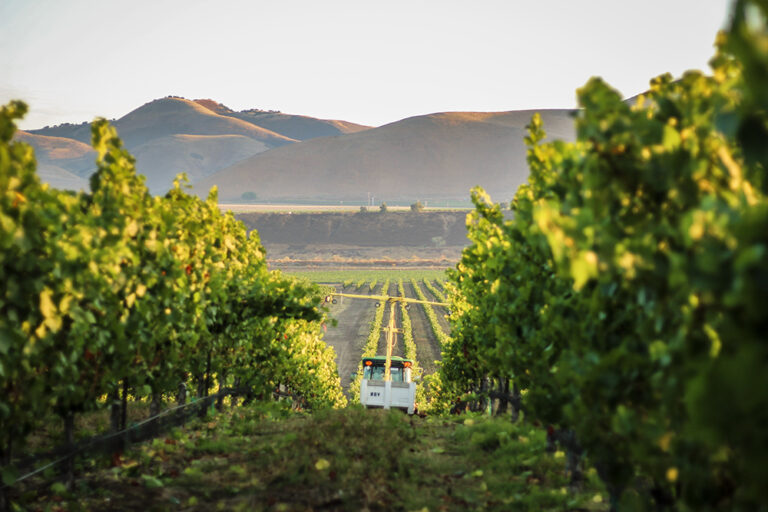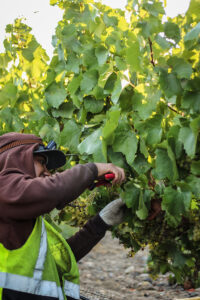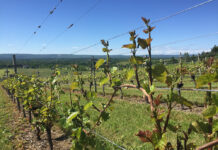
Anyone who travels to California’s Central Coast knows it is a hot spot for agriculture. A visit quickly reveals the sheer diversity of natural ecosystems, from beaches and coastal ranges to rolling hills and rangeland.
Along with the ecological diversity comes a range of development and activity, including dedicated wildlife preserves and numerous agricultural operations.
Thanks to the Pacific Ocean’s influences, one of the Central Coast’s top commodities is winegrapes. Over the past couple of centuries, its valleys and rolling hills have become home to dozens of world-renowned vineyards and wineries.
Winegrape vineyards ranging from a few to several hundred acres can be found across the region and are typically grown as monoculture crops.
In monoculture farming, the same crop grows on the same land yearly. Since vines stay in the ground producing grapes for decades, monoculture farming makes sense for the plant and the grower.
Cultivating Diverse Habitats
Although monoculture farming is the right move for winegrapes, limiting biodiversity in an area year after year can take a toll on the natural habitat. Biodiversity suffers when soils are disrupted and plant life is limited.
Soil contains a lot of life, including beneficial bacteria, fungi and much more. These lifeforms offer ecological benefits like nutrient conversion and transportation, and plant growth stimulation and decomposition.
Working hand-in-hand with microbial life below the soil, the native plant life that grows from it plays a major role in the carbon cycle. Native plant species are especially adept at sequestering carbon, as they thrive in the area’s climate and conditions and don’t depend on external interventions to remain resilient.
But by preserving and regenerating natural habitat alongside cultivating their crops, vineyard growers can reap the benefits of biologically rich soils and help regulate the amount of CO2 in the atmosphere.
Agricultural systems become more resilient and functional under changing climate conditions when they include a variety of plant, animal, fungal and bacterial life.
The regenerative nature of the practices sustainable vineyard stewards use comes from the founding principle that farming practices influence a system much larger than just the vineyard, more commonly referred to as the whole farm system, which includes the vines, the rows between the vines, the wildlife habitat, adjacent oak and riparian areas, surrounding wetlands, receiving waters and other non-cropped areas.
Balancing Mechanization and Hands-On Work
Sustainable vineyard stewards like Maverick Farming in Santa Maria, Calif. take a big-picture approach to their management practices. They manage several commercial vineyards on California’s Central Coast, so many of their vineyard sites have rows of vines planted up and along steep hills.
Managing sloped crops poses navigational challenges, which is why many vineyard owners turn to experienced management companies who have the tools and experience necessary to handle these challenges.
Maverick uses tractors and heavy equipment to perform generalized tasks like discing and leveling soil. When these tasks are mechanized, workers can dedicate their time and expertise to tasks that require more skill and precision.

On top of increasing efficiency, mechanization makes for a safer work environment. People specializing in hands-on vineyard care need to walk up and down each and every row of vines. Gopher mounds pose a safety risk to people as they move through the vineyard rows, which is why Maverick brings in equipment to level them out.
But there are downsides to driving tractors through the rows of vines.
Heavy equipment compacts the soil. When soil becomes too tight for water to soak, roots aren’t optimally hydrated.
Additionally, when water can’t permeate the soil, it is more prone to running off the property, posing a threat to water quality.
Finally, agitating soil with tilling practices hinders its biological activity. When the habitats of soil microbes and beneficial insects are disrupted, the biological benefits they offer are weakened.
Caring for The Whole Farm System
Knowing that tilling the hilled rows is both necessary and risky, Maverick changed their tilling practices. By doing so, they have found a balance that preserves worker safety and enhances biodiversity in their vineyards.
The vineyard blocks that are sloped and prone to higher water runoff are now on a five-year discing rotation cycle. This allows the vineyard floor to be made level and safe for workers, and it gives time for native grasses to establish themselves as cover crops.
Chad Foster has been with Maverick since 2015. As operations manager for the company’s Santa Barbara and San Luis Obispo county vineyards, he has seen the progression of these reduced tillage blocks as they progress through the five-year cycle.

“The biggest thing we’ve noticed from an everyday standpoint,” Foster said, “is improved water infiltration. Now that the cover crops are nice and established, their deep roots help guide the water further into the soil.”
Plant life offers benefits to both water infiltration and quality. As well as guiding water deep into the soil, roots act as a filter that holds sediment in place. This keeps water on the property rather than allowing it to run off and contribute to water pollution.
Moreover, when leaves and stems above ground catch falling rain, they reduce the impact of water drops, thus reducing erosion potential. Soil erosion compromises soil quality and fertility, potentially reducing the quality of grapes and threatening surrounding areas.
But that is not all. Cover crops like the native grasses that flourish in the sloped blocks of Maverick’s properties also serve as homes, food and mating and hunting grounds for insect life.
Foster noticed an uptick in lacewing and ladybugs where the native grasses flourish. These beneficial insects are natural predators to the mites, mealybugs and aphids which are common vineyard pests. Encouraging functional predator/prey relationships enables a vineyard steward to reduce chemical inputs that would otherwise be needed to manage insect pests.
While discing and leveling are still periodically necessary due to vertebrate pests and tractor compaction, Foster said the new rotation cycle that allows the native grasses to thrive has benefited their soils, vines and insect activity.
Operations like Maverick that implement SIP Certified® sustainable practices have an easier time managing a property that experiences reduced erosion and greater water holding capacity, improved carbon and nitrogen cycling, and a plethora of biological activity.
On top of contributing to healthier production sites, farming in a way that cares for the whole farm system leads to a healthier ecosystem that can support many forms of life through the commodities it produces and the regenerative habitat it provides.
While cultivating biologically diverse habitats is a remarkable component in a sustainable winegrowing operation, sustainability doesn’t stop in the vineyard. In the next Sustainable Story, learn about how an estate vineyard and winery in Paso Robles, Calif. involves their entire team in their sustainable business practices.






